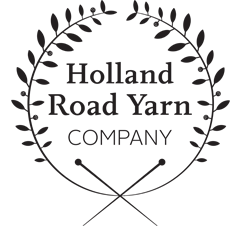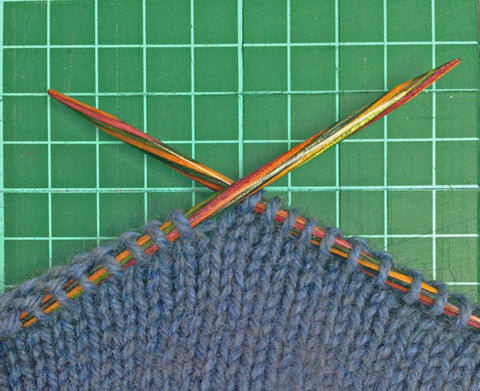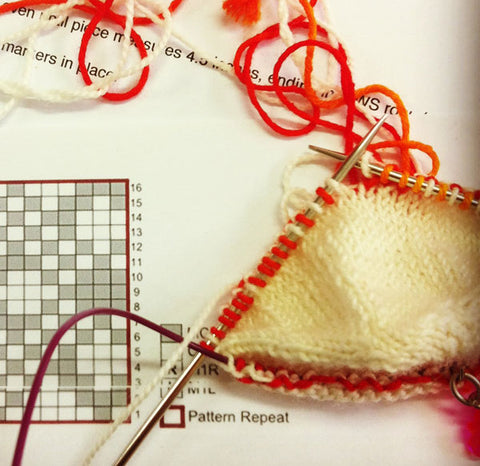Knitting Needles: A Guide.
Not all knitting needles are created equal. One recurring question we get in the shop is 'what needle should I use?' I almost always reply with a question (annoying, aren't I?!), something along the lines of 'what yarn are you knitting with?' or 'do you have a preference for nickel or wood?' or 'what are you knitting?'
I'm not trying to be annoying with those questions. It's usually to figure out the best knitting needle to recommend, and there is a whole host of information I draw on to make a suggestion. About time it all got written down!
Circular or Straight?
Circular. Every time. They are better for your hands as your work sits between the needles, rather than on either side. Transferring project weight from one side of your body to the other pulls your wrists down in a way that can cause RSI and muscle pain. The weight resting on your lap (or whatever you are sitting in front of) means you can keep your hands and wrists in a comfortable, natural position.
Don't be confused by the word 'circular'. I only ever knit on circs, no matter the project. Knitting something flat? Imagine that you are knitting with two straight needles, they just happen to be joined together so you don't lose one or the other. Your work is turned the same way as you would with straights, and of course the magic of circulars is: knitting in the round! Hooray! It saves lots of seaming and allows shapes to be formed which would otherwise be difficult on straights. Because they're straight. Not bendy and curvy. Bodies are bendy and curvy so circulars make a whole lot of sense for knitting garments.
The only time i'll recommend straight needles is if someone is a beginner knitter, or tucks their needle under one arm when they knit. Otherwise, circulars all the way.
Wood
Be it bamboo, laminated wood, birch, or some unknown tree that went into the making of the needle, wood is tops. It's warm, flexible, and very kind to your hands. Yes, it tends to cost a little more than some other needle types, but it's worth it.
Wood needles tend to have good grip on stitches, which makes them excellent for:
-
slippery yarns (such as silk, alpaca and machine washable yarns)
-
cables (especially cables worked without a cable needle)
-
beginner knitters
I usually opt for wood needles when making large projects - cardigans, jerseys etc - as they are kinder on my hands when things get a bit heavy and i'm doing a lot of knitting.
Other things to be aware of: they break. Particularly the smaller sizes, which are fragile and need to be handled with a bit of care. If you're a super tight knitter this can be problematic. It's also best not to leave them in places they may get stepped on.
Metal
Rule number one: don't go anywhere near steel, or plastic with steel inner needles. They are cold, hard and unforgiving. Your hands will hate you for it, and life is too short for working with such awful tools.
At Holland Road Yarn Co we stock Knit Pro Nova and Addi Clicks. They are both hollow brass (read: light and forgiving) and nickel plated (read: warm, smooth and fast). Obviously this proves problematic for those with nickel allergies, which is a shame. Lucky we have other options!
Because of the above comment about steel needles, I used to look at nickel plated needles with scorn. And then I tried them.
Nickel plated needles are smooth, which makes them excellent for:
-
Grippy yarns (such as non-machine washable yarns, tweedy fibres) (don't you just love my technical language?)
-
Lace knitting
-
Socks
-
Speedy knitters
My first set of Knit Pro needles were the Harmony wood, so most of my collection is made up of them. However, i'll opt for nickel wherever I can as I tend to be a speedy gonzales knitter. With nickel, stitches fly from one tip to the other. As mentioned before, I don't like nickel for large, heavy projects as I do get hand fatigue much faster than with wood.
Plastic
Good old plastic fantastic. The best things about plastic? It's super flexible and cheap. Knit Pro produce acrylic tips, which are nice and bendy so extra good for sensitive bones. They are more forgiving than wood, but thanks to this forgiveness, they do have a greater tendency to break. Plastic is perfect for new knitters, as they aren't as much of an investment as wood or nickel.
When I started writing this post I didn't realise just how much I had to say on the topic of knitting needles. Apparently I could go on and on forever, but I won't. Basically, there's a whole lot of factors to take into account when choosing the right tools for your knitting projects. At the end of the day personal preference will override any advice I give you. Try out a few different kinds, talk to your friends, come into the shop and ask us lots of questions. Keep in mind that good quality tools are worth it: they contribute to your enjoyment of the process, and have an affect on the wellbeing of your hands.
Happy knitting!




Comments
Janice said:
I inherited a whole box full of old plastic needles, and a few really old ones made of caesein (I think) from my Mum, so only very recently discovered the joy of new wooden needles. I agree that metal are awful, the old plastic ones are good (once you weed out the ones that the cat has chewed the end of)…
Jisun said:
Enjoyed reading about circular needle. I"ve forever put off learning how to use them but noq im all motivated :) thanks Tash
Nancy Thompson said:
Thanks Tash – I learned some new stuff here. I love technical details :)
Rachelle said:
Funnily enough I love my metal needles. I’ve got Hiya Hiya and Chiao Goo stainless needles and find them excellent to work with. Not so keen on the Knit Pro ones as they’re so sharp I keep poking holes in my fingers. I do a lot of knitting on small needles (socks) so those pointy tips are really pointy! About to try their carbon fibre ones though; have high hopes for them.